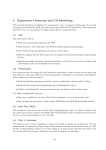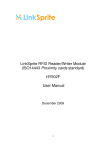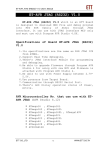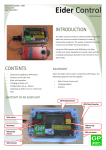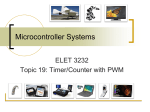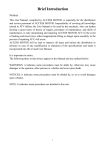Download Input Switches
Transcript
Lecture Overview • Input devices Microprocessors & Interfacing – Input switches • Basics of switches – Keypads Input/Output Devices • Output devices – LCD Lecturer : Dr. Annie Guo S2, 2008 COMP9032 Week8 1 S2, 2008 Input Switches COMP9032 Week8 2 Input Switches (cont.) • Most basic binary input devices • The switch output is high or low, depending on the switch position. • Pull-up resistors are necessary in each switch to provide a high logic level when the switch is open. • Problem with switches: Vcc Vcc R Typically 1K Ohm Logic high with switch open ½ 74LS244 Octal Buffer Logic low with switch closed Data Bus – Switch bounce. • When a switch makes contact, its mechanical springiness will cause the contact to bounce, or contact and break, for a few milliseconds (typically 5 to 10 ms). S2, 2008 COMP9032 Week8 (a) Single-pole, single-throw (SPST) logic switch Data Bus 3 S2, 2008 (b) Multiple pole switch. COMP9032 Week8 4 NAND Latch Debouncer Software Debouncing • Basic idea: wait until the switch is stable • For example: Vcc – Wait and see: • If the software detects a low logic level, indicating that switch has closed, it simply waits for some time, say 20 to 100ms, and then test if the switch is still low. Logic high with switch up – Counter-based approach: • Initialize a counter to 10. • Poll the switch every millisecond until the counter is either 0 or 20. If the switch output is low, decrease the counter; otherwise, increment the counter. • If the counter is 0, we know that switch output has been low (closed) for at least 10 ms. If, on the other hand, the counter reaches 20, we know that the switch has been open for at least 10 ms. Logic low with switch down S2, 2008 COMP9032 Week8 5 S2, 2008 One-Dimensional Array of Switches COMP9032 Week8 6 One-Dimensional Array of Switches Vcc A • Switch bouncing problem must be solved – Either using software or hardware I0 74LS151 8 to 1 I1 Multiplexer I2 Scanned Switch Data I3 To Input Port Z I4 I5 I6 I7 E S2 S1 S0 • The array of switches must be scanned to find out which switches are closed or open. – Software is required to scan the array. As the software outputs a 3-bit sequence from 000 to 111, the multiplexer selects each of the switch inputs. – The output of switch array could be interfaced directly to an eight-bit port at point A. Selected Input From Output Port S2, 2008 COMP9032 Week8 7 S2, 2008 COMP9032 Week8 8 Vcc Keyboard Matrix of Switches (cont.) Keyboard Matrix of Switches 12 00 01 02 10 11 12 74LS151 8-to-1 Input Multiplexer A 06 07 I0 I1 17 I2 Scanned Switch Data I3 To Input Port I4 Z I5 I6 B 70 71 77 I7 E S2 S1 S0 • A keyboard is an array of switches arranged in a two-dimensional matrix. • A switch is connected at each intersection of vertical and horizontal lines. • Closing the switch connects the horizontal line to the vertical line. • 8*8 keyboard can be interfaced directly into 8-bit output and input ports at point A and B. Vcc O0 O1 E3 E2 O2 E1 74LS138 3-of-8 Decoder S2, 2008 O3 O4 O5 A2 O6 A1 O7 A0 Select Input From Output Port Scan Input From Output Port COMP9032 Week8 9 S2, 2008 COMP9032 Week8 Keyboard Matrix of Switches (cont.) Ghosting • Software can scan the key board by outputting a three-bit code to the decoder and then scanning the multiplexer to find the closed switch or switches. Vcc R3 – The combination of the two 3-bit scan codes (A2A1A0 and S2S1S0) identifies which switch is closed. For example, the code 000000 scan switch 00 in the upper left-hand corner. • The diode prevents a problem called ghosting. S2, 2008 COMP9032 Week8 10 R2 R1 Col 0 Col 1 Col 2 00 01 02 10 11 12 20 21 22 Row 0 (Pulled low, error) Row 1 (Pulled low, OK) Row 2 (High, OK) Low (Scanned column) 11 S2, 2008 COMP9032 Week8 12 Ghosting (cont.) Example • Ghosting occurs when several keys are pushed at once. • Consider the case shown in the figure where three switches 01, 10 and 11 are all closed. Column 0 is selected with a logic low and assume that the circuit does not contain the diodes. As the rows are scanned, a low is sensed on Row 1, which is acceptable because switch 10 is closed. In addition, Row 0 is seen to be low, indicating switch 00 is closed, which is NOT true. The diodes in the switches eliminate this problem by preventing current flow from R1 through switches 01 and 11. Thus Row 0 will not be low when it is scanned. • Get an input from 4*4 keypad S2, 2008 S2, 2008 COMP9032 Week8 13 2 3 A R0 4 5 6 B R1 7 8 9 C R2 * 0 # D R3 C0 C1 C2 C3 Example (solution) COMP9032 Week8 14 Code Implementation • Algorithm ; The program gets input from keypad and displays its ascii value on the ; LED bar .include "m64def.inc" Scan columns from left to right for each column, scan rows from top to bottom for each key being scanned if it is pressed display wait endif endfor endfor Repeat the scan process – A column is selected, its related Cx value is set to 0. – A mask is used to read one row at a time. S2, 2008 1 COMP9032 Week8 15 .def row =r16 .def col =r17 .def rmask =r18 .def cmask =r19 .def temp1 =r20 .def temp2 =r21 ; current row number ; current column number ; mask for current row during scan ; mask for current column during scan .equ PORTDDIR =0xF0 .equ INITCOLMASK = 0xEF .equ INITROWMASK = 0x01 .equ ROWMASK =0x0F ; PD7-4: output, PD3-0, input ; scan from the leftmost column, ; scan from the top row ; for obtaining input from Port D S2, 2008 COMP9032 Week8 16 Code Implementation Code Implementation colloop: RESET: ;ldi ;out ;ldi ;out temp1, low(RAMEND) SPL, temp1 temp1, high(RAMEND) SPH, temp1 ; initialize the stack delay: cpi breq out col, 4 main PORTD, cmask ldi dec brne temp1, 0xFF temp1 delay ; slow down the scan operation ; read PORTD ; get the keypad output value ; check if any row is low ; if all keys are scanned, repeat ; otherwise, scan a column ldi out ser out out temp1, PORTDDIR DDRD, temp1 temp1 DDRC, temp1 PORTC, temp1 ; PD7:4/PD3:0, out/in ; PORTC is output in andi cpi breq temp1, PIND temp1, ROWMASK temp1, 0xF nextcol ldi clr cmask, INITCOLMASK col ; initial column mask ; initial column ldi clr rmask, INITROWMASK row main: S2, 2008 COMP9032 Week8 17 S2, 2008 COMP9032 Week8 Code Implementation rowloop: cpi breq mov and breq inc lsl jmp row, 4 nextcol temp2, temp1 temp2, rmask convert row rmask rowloop lsl cmask inc col jmp colloop S2, 2008 18 Code Implementation convert: cpi breq ; the row scan is over. ; check un-masked bit ; if bit is clear, the key is pressed ; else move to the next row ; increase column value ; go to the next column COMP9032 Week8 19 col, 3 letters ; if the pressed key is in col.3 ; we have a letter ; if the key is not in col.3 and ; if row scan is over nextcol: ; if yes, find which row is low ; initialize for row check ; S2, 2008 cpi breq row, 3 symbols ; if the key is in row3, ; we have a symbol or 0 mov lsl add add subi jmp temp1, row temp1 temp1, row temp1, col temp1, -'1' convert_end ; otherwise we have a number in 1-9 ; ; temp1 = row*3 + col ; add the value of character ‘1’ COMP9032 Week8 20 Code Implementation LCD letters: ldi temp1, 'A' add temp1, row jmp convert_end • Liquid Crystal Display • Programmable output device ; Get the ASCII value for the key symbols: cpi col, 0 breq star cpi col, 1 breq zero ldi temp1, '#' jmp convert_end ; check if we have a star ldi temp1, '*' jmp convert_end ; set to star ldi temp1, '0' ; set to zero ; or if we have zero ; if not we have hash star: zero: convert_end: out PORTC, temp1 jmp main S2, 2008 ; write value to PORTC ; restart main loop COMP9032 Week8 21 S2, 2008 Dot Matrix LCD COMP9032 Week8 22 Pin Assignments • Characters are displayed using a dot matrix. – 5x7, 5x8, and 5x11 • A controller is used for communication between the LCD and other devices,e.g. MPU • The controller has an internal character generator ROM. All display functions are controllable by instructions. S2, 2008 COMP9032 Week8 23 S2, 2008 COMP9032 Week8 24 Pin Descriptions S2, 2008 COMP9032 Week8 Dot Matrix LCD Diagram 25 S2, 2008 Operations COMP9032 Week8 26 Operations (cont.) – The register select (RS) signal determines which of these two register is selected. • MPU communicates with LCD through two registers – Instruction Register (IR) • To store instruction code like Display clear or Cursor Shift as well as addresses for the Display Data RAM (DD RAM) or the Character Generator RAM (CG RAM) – Data Register (DR) • To temporarily store data to be read/written to/from the DD RAM of the display controller. S2, 2008 COMP9032 Week8 27 S2, 2008 COMP9032 Week8 28 Operations (cont.) LCD Instructions • When the busy flag is high or “1”, the LCD module is busy with internal operation. • The next instruction must not be written until the busy flag is low or “0”. • For details, refer to the LCD USER’S MANUAL. S2, 2008 COMP9032 Week8 • A list of binary instructions are available for LCD operations • Some typical ones are explained in the next slides. 29 S2, 2008 Instructions • Return Home RS R/W DB7 DB6 DB5 BD4 DB3 DB2 DB1 DB0 0 0 0 0 0 0 0 0 0 1 – The display clears and the cursor or blink moves to the upper left edge of the display. – The execution of clear display instruction sets entry mode to increment mode. S2, 2008 30 Instructions • Clear Display Code COMP9032 Week8 COMP9032 Week8 RS R/W DB7 DB6 DB5 BD4 DB3 DB2 DB1 DB0 Code 0 0 0 0 0 0 0 0 1 x – The cursor or the blink moves to the upper left edge of the display. Text on the display remains unchanged. 31 S2, 2008 COMP9032 Week8 32 Instructions Instructions • Entry Mode Set • Display ON/OFF Control RS R/W DB7 DB6 DB5 BD4 DB3 DB2 DB1 DB0 Code 0 0 0 0 0 0 0 1 I/D S – Sets the Increment/Decrement and Shift modes to the desired settings. • I/D: Increments (I/D = 1) or decrements (ID = 0) the DD RAM address by 1 when a character code is written into or read from the DD RAM. • The cursor or blink moves to the right when incremented by +1. • The same applies to writing and reading the CG RAM. • S: Shifts the entire display either to the right or to the left when S = 1; shift to the left when I/D = 1 and to the right when I/D = 0. S2, 2008 COMP9032 Week8 33 Code RS R/W DB7 DB6 DB5 BD4 DB3 DB2 DB1 DB0 0 0 0 0 0 0 1 D C B – Controls the display ON/OFF status, Cursor ON/OFF and Cursor Blink function. • D: The display is ON when D = 1 and OFF when D = 0. • C: The cursor displays when C = 1 and does not display when C = 0. • B: The character indicated by the cursor blinks when B = 1. S2, 2008 COMP9032 Week8 Instructions Instructions • Function Set • Cursor or Display Shift Code RS R/W DB7 DB6 DB5 BD4 DB3 DB2 DB1 DB0 0 0 0 0 0 1 S/C R/L x x S2, 2008 Code • DL = “1”, 8 –bits; otherwise 4 bits • N: Sets the number of lines – N = “0” : 1 line display – N = “1” : 2 line display Shifts cursor position to the left (AC is decremented by one) Shifts cursor position to the right (AC is incremented by one) Shifts the entire display to the left. The cursor follows the display shift. Shifts the entire display to the right. The cursor follows the display shift. COMP9032 Week8 RS R/W DB7 DB6 DB5 BD4 DB3 DB2 DB1 DB0 0 0 0 0 1 DL N F x x – Sets the interface data length, the number of lines, and character font. – Shifts the cursor position or display to the right or left without writing or reading display data. S/C R/L 0 0 0 1 1 0 1 1 34 35 • F: Sets character font. – F = “1” : 5 x 10 dots – F = “0” : 5 x 7 dots S2, 2008 COMP9032 Week8 36 Instructions Instructions • Write Data to CG or DD RAM • Read Busy Flag and Address Code RS R/W DB7 DB6 DB5 BD4 DB3 DB2 DB1 DB0 0 1 BF A A A A A A A – Reads the busy flag (BF) and value of the address counter (AC). BF = 1 indicates that on internal operation is in progress and the next instruction will not be accepted until BF is set to “0”. If the display is written while BF = 1, abnormal operation will occur. S2, 2008 COMP9032 Week8 37 Code – Writes binary 8-bit data DDDDDDDD to the CG or DD RAM. – The previous designation determines whether the CG or DD RAM is to be written (CG RAM address set or DD RAM address set). After a write the entry mode will automatically increase or decrease the address by 1. Display shift will also follow the entry mode. S2, 2008 Timing Characteristics COMP9032 Week8 COMP9032 Week8 38 Timing Characteristics • For write operation S2, 2008 RS R/W DB7 DB6 DB5 BD4 DB3 DB2 DB1 DB0 1 0 D D D D D D D D • For read operation 39 S2, 2008 COMP9032 Week8 40 Examples Examples • Send a command to LCD • Send data to display ; Register data stores value to be written to the LCD ; Port D is output and connects to LCD; Port A controls the LCD. ; Assume all other labels are pre-defined. .MACRO lcd_write_com out PORTD, data clr temp out PORTA, temp nop sbi PORTA, LCD_E nop nop nop cbi PORTA, LCD_E nop nop nop S2, 2008 .ENDMACRO ; comments are same as in previous slide. ; set the data port's value up ; RS = 0, RW = 0 for a command write ; delay to meet timing (Set up time) ; turn on the enable pin ; delay to meet timing (Enable pulse width) ; turn off the enable pin ; delay to meet timing (Enable cycle time) COMP9032 Week8 41 .MACRO lcd_write_data out PORTD, data ldi temp, 1 << LCD_RS out PORTA, temp nop sbi PORTA, LCD_E nop nop nop cbi PORTA, LCD_E nop nop nop .ENDMACRO S2, 2008 Examples ; RS = 1, RW = 0 for a data write ; delay to meet timing (Set up time) ; turn on the enable pin ; delay to meet timing (Enable pulse width) ; turn off the enable pin ; delay to meet timing (Enable cycle time) COMP9032 Week8 42 LCD Initialization • Check LCD and wait until LCD is not busy ; comments are same as in the previous slide .MACRO lcd_wait_busy clr temp out DDRD, temp ; Make PORTD be an input port for now out PORTD, temp ldi temp, 1 << LCD_RW out PORTA, temp ; RS = 0, RW = 1 for a command port read busy_loop: nop ; delay to meet set-up time) sbi PORTA, LCD_E ; turn on the enable pin nop ; delay to meet timing (Data delay time) nop nop in temp, PIND ; read value from LCD cbi PORTA, LCD_E ; turn off the enable pin sbrc temp, LCD_BF ; if the busy flag is set rjmp busy_loop ; repeat command read clr temp ; else out PORTA, temp ; turn off read mode, ser temp ; out DDRD, temp ; make PORTD an output port again S2, 2008 COMP9032 Week8 43 .ENDMACRO ; set the data port's value up • LCD should be initialized before use • Internal Reset Circuit can be used, but it is related to power supply loading, may not work properly. • Therefore, software initialization is recommended. S2, 2008 COMP9032 Week8 44 Software Initialization S2, 2008 COMP9032 Week8 Software Initialization 45 Example of Initialization Code S2, 2008 COMP9032 Week8 Example of Initialization Code ldi del_lo, low(15000) ldi del_hi, high(15000) delay .include “m64def.inc” ; The del_hi:del_lo register pair store the loop counts ; each loop generates about 1 us delay .MACRO delay loop: subi del_lo, 1 sbci del_hi, 0 nop nop nop nop ; taken branch takes two cycles. brne loop ; one loop time is 8 cycles = ~1.08us .ENDMACRO ;delay (>15ms) ; Function set command with N = 1 and F = 0 ; for 2 line display and 5*7 font. The 1st command ldi data, LCD_FUNC_SET | (1 << LCD_N) lcd_write_com ; delay (>4.1 ms) ldi del_lo, low(4100) ldi del_hi, high(4100) delay lcd_write_com ; 2nd Function set command ; continued ; continued S2, 2008 COMP9032 Week8 46 47 S2, 2008 COMP9032 Week8 48 Example of Initialization Code Example of Initialization Code ldi del_lo, low(100) ldi del_hi, high(100) delay ; delay (>100 ns) lcd_write_com lcd_write_com ; 3rd Function set command ; Final Function set command lcd_wait_busy ldi data, LCD_DISP_OFF lcd_write_com ; Wait until the LCD is ready lcd_wait_busy ldi data, LCD_DISP_CLR lcd_write_com ; Wait until the LCD is ready lcd_wait_busy ; Wait until the LCD is ready ; Entry set command with I/D = 1 and S = 0 ; Set Entry mode: Increment = yes and Shift = no ldi data, LCD_ENTRY_SET | (1 << LCD_ID) lcd_write_com ; Wait until the LCD is ready lcd_wait_busy ; Display On command with C = 1 and B = 0 ldi data, LCD_DISP_ON | (1 << LCD_C) lcd_write_com ; Turn Display off ; Clear Display ; continued S2, 2008 COMP9032 Week8 49 S2, 2008 Reading Material COMP9032 Week8 50 Homework • Chapter 7: Computer Buses and Parallel Input and Output. Microcontrollers and Microcomputers by Fredrick M. Cady. 1. Write an assembly program to initialize LCD panel to display characters in one line with 5x7 font. – Simple I/O Devices • DOT Matrix LCD User’s Manual – Available on the course website. S2, 2008 COMP9032 Week8 51 S2, 2008 COMP9032 Week8 52













